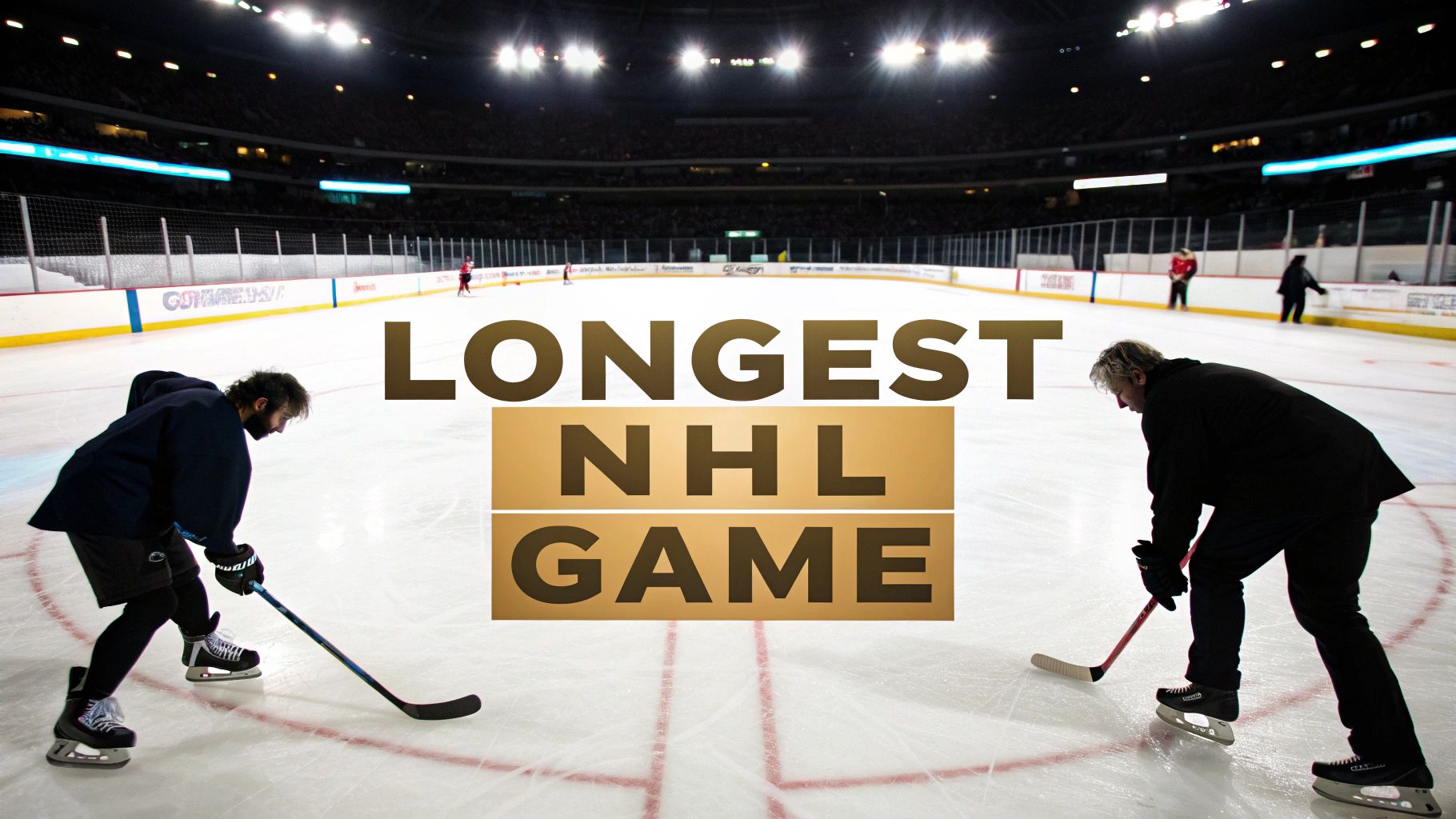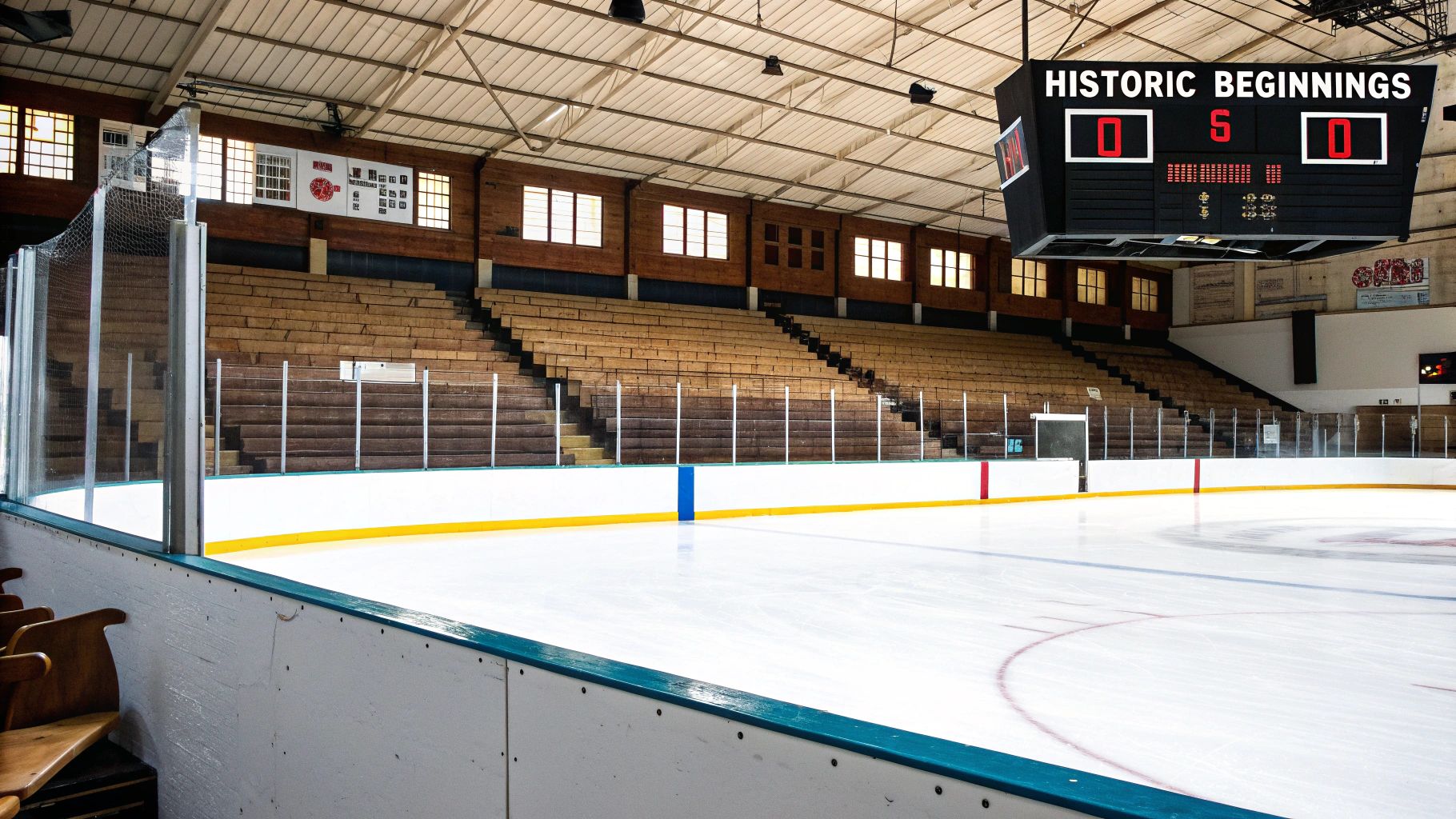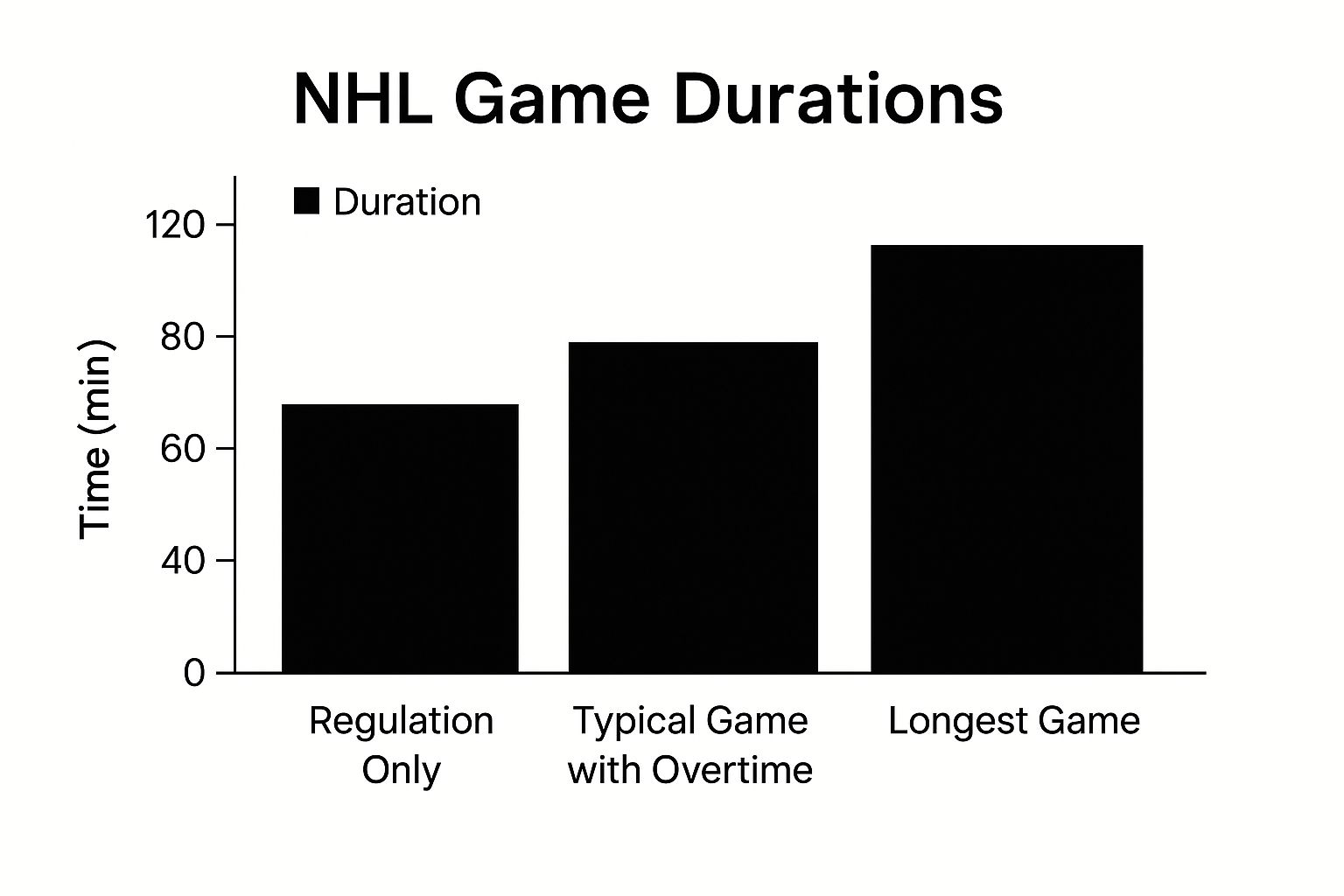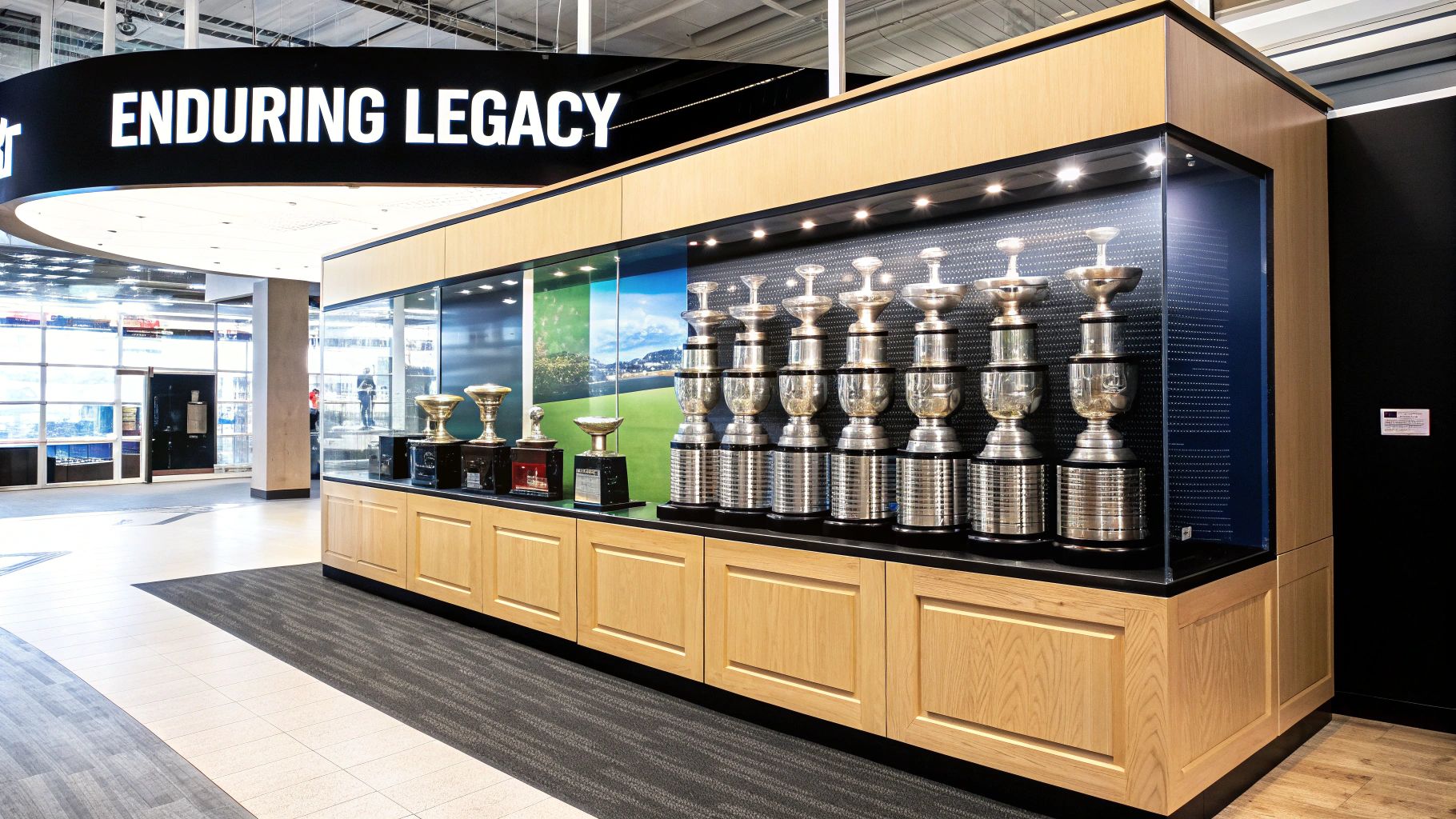The Longest Game in NHL History an Unforgettable Marathon

On March 24, 1936, the Detroit Red Wings and the Montreal Maroons faced off in a Stanley Cup Playoff game that would go down in legend. It became the longest game in NHL history, a gruelling six-overtime marathon that lasted an incredible 176 minutes and 30 seconds of ice time before a single puck found the back of the net. This contest remains the ultimate benchmark for endurance in professional hockey.
A Night of Unprecedented Endurance

Think about a hockey game that just refuses to end. That's exactly what happened during the 1936 NHL Semifinals when the Red Wings and Maroons skated into the history books. After sixty minutes of scoreless regulation play, the teams battled through one overtime, then two, then five, with neither side able to break the deadlock.
The game quickly became a pure test of human will, pushing players to their absolute physical and mental limits. This legendary contest dragged on for an astonishing 116 minutes and 30 seconds of overtime alone—almost the equivalent of playing two full games back-to-back.
The only goal of the entire night finally came from a rookie named Mud Bruneteau, securing a hard-fought 1-0 victory for Detroit and ending the historic stalemate. You can find more details about this and other incredible marathon NHL games over at NBC Sports.
The 1936 Stanley Cup Semifinal At a Glance
This was far more than just a long game; it was a defining moment for the sport. The sheer duration set a record that has stood firm for over 85 years, a testament to the incredible resilience of the players involved.
The game stretched so late into the night—ending around 2:25 AM—that reports from the era mention players drinking coffee and milk between periods just to stay conscious, while the ice crew struggled to maintain the playing surface.
To really wrap your head around the scale of this event, it helps to see the key details laid out. The table below gives a quick, digestible summary of the facts that make this contest a cornerstone of NHL lore.
| Statistic | Details |
|---|---|
| Date | March 24, 1936 |
| Matchup | Detroit Red Wings vs. Montreal Maroons |
| Venue | Montreal Forum |
| Final Score | 1-0 (Detroit) |
| Total Overtimes | Six (6) |
| Total Game Time | 176 minutes, 30 seconds |
| Game-Winning Goal | Mud Bruneteau |
From the six overtimes to the single, decisive goal, every element of this game highlights why it's remembered as an almost mythical clash of titans.
Stepping Back to the 1936 Stanley Cup Playoffs
To really get a feel for why this game became the longest in NHL history, you have to picture what hockey was like back in the 1930s. It wasn't the sport we see today. This was an era of pure grit, played in a much smaller league where every single game felt monumental. The equipment was basic, the players were built like tanks, and endurance was everything.
The 1936 Stanley Cup Playoffs set the stage for a classic clash. In one corner, you had the Detroit Red Wings, a hungry, rising team in the American Division managed by the legendary Jack Adams. They had a strong season, finishing with a 24-16-8 record, and were desperate to win their first-ever Stanley Cup.
On the other side stood the Montreal Maroons, the reigning 1935 Stanley Cup champions. The Maroons were a seasoned, powerful club from the Canadian Division, known for their suffocating, physical style of defence. They were dead set on a repeat championship, which made this semifinal showdown incredibly tense from the get-go.
The Playoff Gauntlet of 1936
The playoff format back then was a pressure cooker. Forget today's lengthy four-round marathon; this was a much shorter, more brutal affair. This semifinal was a best-of-five series, which put an immense amount of weight on the very first game. It wasn't just a warm-up; it was a battle for control in a series that could be over in a flash.
For the Maroons, dropping the first game on home ice would have been a disaster. For the Red Wings, grabbing a win on the road would have been the perfect way to set the tone. You can see why neither side was willing to give an inch, no matter how long the game dragged on.
The pressure cooker of a best-of-five series meant that the outcome of Game 1 could realistically shape the entire championship path. Both teams knew that this single game could be the difference between advancing and going home.
The NHL itself was a different beast entirely. With only eight teams in the league, rivalries were fierce and deeply personal. It was a tight-knit world where everyone knew everyone else's moves, making every goal a hard-won victory of skill and wit. For those curious about this foundational era, you can learn more about the history of the Original Six NHL teams and the rivalries that built the sport.
It was this perfect storm—a short, intense playoff format, a bitter rivalry, and the sheer toughness of the players—that created the conditions for a game that just wouldn't end.
A Moment-by-Moment Look at the Game

When the puck first dropped at the Montreal Forum, nobody in attendance had any inkling they were about to witness hockey history. The first sixty minutes of Game 1 played out as a tense, strategic chess match. Both the Detroit Red Wings and the hometown Montreal Maroons were locked in a fierce defensive battle where every rush was snuffed out and every shot was turned aside.
The final buzzer of regulation echoed through the arena, but the scoreboard told the whole story: 0-0. A scoreless tie. This sent the game straight into sudden-death overtime, that nail-biting scenario where the very next goal would end it all. You could feel the tension ratcheting up as the first extra period got underway.
One overtime wasn't enough. Neither was a second. The high-flying, aggressive hockey that started the game slowly began to fade, replaced by a cautious, grinding style of play as sheer exhaustion took over. By the time the third overtime concluded, the game had already lasted longer than a second full game, yet neither team had managed to find the back of the net.
The War of Attrition Begins
Those short intermissions between periods became desperate chances to refuel. Legends from that night tell of players grabbing anything they could get their hands on—a quick cup of coffee, a glass of milk, even a stray hot dog—just to keep going. The ice itself, chewed up by hours of non-stop skating, was getting choppy and slow, making crisp passes a near-impossible task.
This punishing pace pushed these athletes to the absolute edge of their physical and mental limits. Skaters' legs felt like lead and their minds were foggy with fatigue, but still, they battled on. The contest had morphed from a display of skill into a raw test of willpower.
The game dragged on for so long that players reportedly lost all track of time. Detroit's Mud Bruneteau later confessed he was so drained, his only goal was to survive his next shift without making a critical error.
As the clock ticked past midnight, the once-packed stands began to empty. Only the most die-hard fans remained, and they were rewarded with a spectacle of pure, unadulterated grit as two completely spent teams simply refused to give in.
The Sixth Overtime and an Unlikely Hero
Finally, deep into the sixth overtime period, the end arrived when no one expected it. Hec Kilrea, a forward for the Red Wings, managed to corral the puck in the neutral zone. He carried it into the Maroons' end with whatever fumes he had left in the tank.
Spotting a sliver of an opening, Kilrea slid a pass across the ice to a young rookie named Mud Bruneteau. Bruneteau, who was so exhausted he was practically skating in his sleep, got just enough on the pass to fire a quick shot toward the net.
The puck flew past the equally exhausted Maroons goalie, Lorne Chabot, and rippled the twine. It was 2:25 AM. After 116 minutes and 30 seconds of gruelling overtime hockey, the longest game in NHL history was over. The Red Wings had won, 1-0. The few fans still in the building erupted, celebrating the end of a marathon that would be etched into hockey lore forever.
Spotlight on the Game's Iron Men
While the game itself is the stuff of legend, the individual stories of the players who lived through it are just as incredible. This wasn't just a statistical blip on the NHL's timeline; it was a pure test of human will, pushed to the absolute limit by a few key men. Their performances are what elevated this marathon from just another game into a genuine piece of hockey mythology.
The most famous name to come out of that night is, of course, the unlikely hero: Modere "Mud" Bruneteau. A rookie forward for the Red Wings, Bruneteau was far from a star. In fact, he'd only managed two goals throughout the entire regular season. He was probably the last person anyone in the building expected to end the historic standoff.
But there he was. After what felt like three full games of hockey, it was Bruneteau who found that last ounce of energy, got himself into position, and fired the shot that finally sent everyone home. That one goal etched his name into hockey history forever, a perfect reminder that when the pressure is at its peak, heroes can come from anywhere.
The Unbeatable Last Lines of Defence
Just as crucial to this story, though, were the two men guarding the nets at opposite ends of the ice. The goaltenders, Detroit’s Normie Smith and Montreal’s Lorne Chabot, were locked in one of the most unbelievable duels the sport has ever seen. For 176 minutes and 30 seconds straight, neither of them broke.
Smith, in particular, put on a clinic. He stopped every single puck the Maroons threw at him, setting an NHL record for the most saves in a single game that still stands today. His shutout that night is easily one of the most monumental feats in playoff history.
Normie Smith faced a staggering 92 shots from the Montreal Maroons and stopped every one of them. To put that into perspective, a busy night for a modern goalie might see them face 30-40 shots. Smith handled more than double that, all with the game on the line.
Chabot was every bit as brilliant for Montreal, turning away a relentless Red Wings attack until Bruneteau’s final, game-winning shot finally slipped past him. It’s almost impossible to imagine the sheer mental toughness required to stay that focused for nearly three hours of sudden-death hockey.
Both goalies showcased a level of stamina that completely redefined what people thought was possible for the position. When you dig into the metrics that define goaltending greatness, like those covered in our guide to NHL goalie save percentage, their performance becomes even more astounding. These men were the true iron-willed backbone of this historic night.
Breaking Down the Marathon by the Numbers
You can talk about endurance and grit all day, but the raw numbers from this game are what truly boggle the mind. They tell a story that goes way beyond a simple 1-0 score, painting a vivid picture of a contest that pushed hockey to its absolute limits.
Let's start with the goalies, because their performances were nothing short of legendary. Detroit's Normie Smith was a human wall, turning away an unbelievable 92 shots from the Montreal Maroons. Ninety-two! He didn't let a single one get past him, setting an NHL record for the most saves in a shutout that still stands today. Down at the other end, Lorne Chabot was nearly his equal, stopping 66 of the 67 shots he faced.
Think about that. It wasn't a defensive stalemate where nothing was happening. It was a relentless offensive barrage from both sides, met by two goaltenders having the game of their lives.

The total ice time clocked in at a staggering 176 minutes and 30 seconds. That’s basically the same as playing three full regulation games back-to-back, all in one night. It’s a feat of pure stamina that’s almost impossible to imagine in today's game, even with all the modern advancements in training and nutrition.
How It Stacks Up Historically
The 1936 marathon didn't just break a record; it set a high-water mark that has defined the absolute peak of playoff hockey endurance ever since. Sure, other games have gone deep into overtime, but none have seriously threatened this six-overtime epic. It's not just a record; it's an outlier.
To put it in perspective, here’s how the 1936 game compares to the other longest playoff battles in league history.
Top 5 Longest Games in NHL History
| Rank | Date | Matchup | Overtime Duration |
|---|---|---|---|
| 1 | Mar. 24, 1936 | Detroit Red Wings vs. Montreal Maroons | 116:30 |
| 2 | Apr. 3, 1933 | Toronto Maple Leafs vs. Boston Bruins | 104:46 |
| 3 | May 4, 2000 | Philadelphia Flyers vs. Pittsburgh Penguins | 92:01 |
| 4 | Aug. 11, 2020 | Tampa Bay Lightning vs. Columbus Blue Jackets | 90:27 |
| 5 | Apr. 24, 2003 | Anaheim Ducks vs. Dallas Stars | 80:48 |
As you can see, even the second-place game is a full ten minutes shorter. The 1936 contest truly stands alone.
Of course, every single player on the ice that night made a huge contribution, often in ways that a standard box score can't capture. If you're curious about how to measure that kind of impact with more modern metrics, it’s worth learning about what Wins Above Replacement is and how it evaluates a player’s total value. But in a game like this, it was the ultimate team effort.
What This Game Left Behind

Long after the final whistle blew, the legend of the 1936 marathon has only grown. It’s not just a dusty entry in a record book; it's a core piece of hockey lore, a story of near-superhuman stamina told and retold by fans across generations. This game essentially wrote the definition of playoff intensity.
Think about it. Every time a modern playoff game creeps into a second or third overtime, what happens? Broadcasters and fans immediately start talking about this game. It's the ultimate benchmark, the yardstick against which all other marathon games are measured. It puts into perspective the incredible mental and physical strength needed to play at that level for that long.
How It Forged Two Teams' Identities
The game's legacy is etched into the very fabric of both franchises. For the Detroit Red Wings, this was a pivotal, character-building win on their way to their very first Stanley Cup. It helped forge their identity as a team that simply would not give up.
For the Montreal Maroons, while the loss was crushing, their part in the longest game in NHL history became a defining chapter in their story before the team folded in 1938.
This game is remembered not just for its incredible length, but for what it symbolises: the raw desperation of playoff hockey and the unyielding will of athletes who refused to lose. It remains the gold standard for endurance in the sport.
At its heart, the story of this game captures the very essence of what makes playoff hockey so special. It’s a powerful testament to grit, resilience, and the sheer force of will required to win when everything is on the line.
Still Wondering About the Longest NHL Game?
Even after digging into the story, the sheer scale of this game can be hard to wrap your head around. Let's tackle some of the most common questions people have about this truly historic night in hockey.
So, Who Actually Won the Longest NHL Game Ever?
The Detroit Red Wings finally came out on top. It was a rookie, Mud Bruneteau, who became the hero by scoring the one and only goal deep into the sixth overtime period. His shot ended the marathon after 176 minutes and 30 seconds of play, giving Detroit a 1-0 victory over the Montreal Maroons.
How Long Was the Game From Start to Finish?
The official time on the clock was a mind-boggling 176 minutes and 30 seconds. Think about that for a second. That's the standard 60 minutes of regulation, plus another 116 minutes and 30 seconds of sudden-death overtime. They essentially played another two full games back-to-back.
Has Any Other Game Even Come Close?
A few other playoff games have gone the distance, but nothing has seriously threatened the 1936 record. The next closest was a 1933 battle between the Toronto Maple Leafs and Boston Bruins, which ended after 104 minutes and 46 seconds of overtime. That means the Red Wings-Maroons game is still nearly 12 minutes longer than any other in league history, cementing its legendary status.
The endurance on display in the longest game in NHL history is what really sets it apart. The gap between first and second place on that all-time list just shows how gruelling and unique this particular matchup was for every player on the ice.
Why on Earth Did the Game Go On for So Long?
It really came down to a perfect storm of factors. For one, it was Game 1 of a tense, best-of-five playoff series, so both teams were locked in a fierce defensive struggle with no room for error. But the real story was in the net—both goalies, Normie Smith for Detroit and Lorne Chabot for Montreal, put on an absolute clinic. They stopped a combined 158 shots before someone finally found the back of the net.
For a deeper dive into player statistics, team analytics, and historical NHL data, explore the powerful tools available at PuckNStick. Get the insights you need to understand the game like never before at https://www.pucknstick.com.
